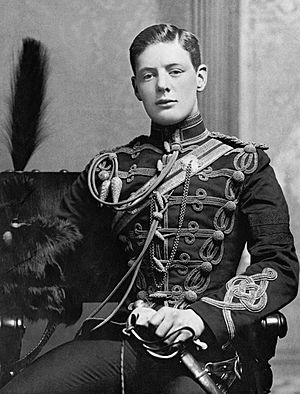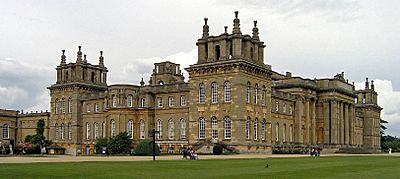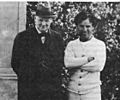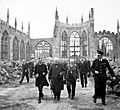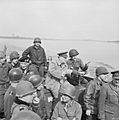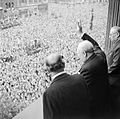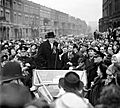Winston Churchill facts for kids
{{Infobox officeholder | image = Sir Winston Churchill - 19086236948.jpg | alt = Churchill wearing a suit, standing and holding a chair | caption = The Roaring Lion, a portrait by Yousuf Karsh at the Canadian Parliament, 30 December 1941. | honorific_prefix = The Right Honourable | name = Sir Winston Churchill | honorific_suffix = KG OM CH TD DL FRS RA | office = Prime Minister of the United Kingdom
| monarch =
| deputy = Anthony Eden | term_start = 26 October 1951 | term_end = 5 April 1955 | predecessor = Clement Attlee | successor = Anthony Eden | monarch1 = George VI | deputy1 = Clement Attlee (1942–1945) | term_start1 = 10 May 1940 | term_end1 = 26 July 1945 | predecessor1 = Neville Chamberlain | successor1 = Clement Attlee | office2 = Father of the House of Commons | term_start2 = 8 October 1959 | term_end2 = 25 September 1964 | predecessor2 = David Grenfell | successor2 = Rab Butler
| module = | module2 = | module3 = | module4 =
Churchill in military uniform in 1895
A young Winston Churchill on a lecture tour of the United States in 1900
Sir Winston Leonard Spencer-Churchill (born November 30, 1874 – died January 24, 1965) was a famous English politician. He served as Prime Minister of the United Kingdom two times. His first term was during World War II, and his second was in the early 1950s.
Churchill was the only person to be part of the British Government during both World War I and World War II. He was also a soldier, journalist, and author. He even won the Nobel Prize in Literature in 1953 for his writing.
Many people consider Churchill one of the greatest British leaders. In a 2002 BBC 2 television poll, he was voted the greatest Briton in history.
Contents
- Early Life and Adventures
- Starting a Political Career
- Churchill's Role in World War I
- Between the World Wars
- Leading Britain in World War II
- After the War and Later Life
- Books by Winston Churchill
- Images for kids
- See also
Early Life and Adventures
Winston Churchill was born on November 30, 1874, at Blenheim Palace in Oxfordshire, England. His father, Lord Randolph Churchill, was a well-known politician. His mother, Jennie Jerome, was American.
As a boy, Churchill attended the famous Harrow School. He later joined the British Army in 1893. He traveled a lot, fighting in places like Pakistan and Sudan.
In 1899, he went to South Africa during the Second Boer War as a newspaper reporter. He was captured by the Boers but managed to escape, which made him famous.
Starting a Political Career
In 1900, Churchill became a politician and was elected to Parliament as a member of the Conservative Party. In 1904, he switched to the Liberal Party, but he later returned to the Conservative Party.
He married Clementine Hozier in 1908. They had five children: Diana, Randolph, Sarah, Marigold, and Mary.
Churchill's Role in World War I
In 1910, Churchill became Home Secretary, a very important government job. In 1911, he was put in charge of the Royal Navy as the First Lord of the Admiralty.
When World War I began, he stayed in this role. He planned an invasion in Gallipoli, which did not go well. Because of this, he had to leave the government. He then joined the army and fought in France, even though he was still a Member of Parliament. In 1917, he became the Minister of Munitions, in charge of military supplies.
Between the World Wars
After World War I, in 1919, Churchill became the Secretary of State for War and for Air. In 1920, he ordered the first air bombing in Africa.
In 1921, he was in charge of the colonies as Secretary of State. He lost an election in 1922 but returned to Parliament in 1924. He rejoined the Conservative Party in 1925 and became Chancellor of the Exchequer (Minister of Finance).
After 1929, Churchill disagreed with many of his party's ideas. He was not given a government job. Instead, he spent his time writing books. He wrote about his ancestor, John Churchill, 1st Duke of Marlborough, and a history book called A History of the English Speaking Peoples.
When Adolf Hitler came to power in Germany, Churchill warned that Britain needed to make its military stronger. He believed Britain should stand up to Hitler, but few leaders listened to him at first.
Leading Britain in World War II
At the start of World War II, Churchill was again put in charge of the Navy. By 1940, the war was going badly for Britain. The Prime Minister, Neville Chamberlain, resigned on May 10, and Churchill became Prime Minister.
Some people thought Britain could not win and should make peace with Hitler. But Churchill was determined to fight on. He gave powerful speeches that inspired the nation.
He became good friends with Franklin D. Roosevelt, the President of the United States. He convinced Roosevelt to send supplies to Britain and help in the war. Churchill also met with Roosevelt and Joseph Stalin, the leader of the Soviet Union. These three leaders were known as the Big Three.
After the War and Later Life
In 1945, Churchill's Conservative party lost an election, and he stopped being Prime Minister. However, he became Prime Minister again in 1951 and served until 1955.
In 1953, he was knighted, becoming Sir Winston. He also won the Nobel Prize in Literature that same year.
Churchill retired from being Prime Minister in 1955 and from Parliament in 1964. In 1963, President John F. Kennedy made him an 'Honorary Citizen of the United States'.
Sir Winston Churchill died from a stroke at the age of 90, in 1965.
Books by Winston Churchill
Churchill was a talented writer. Here are some of his notable books:
- The Story of the Malakand Field Force (1898)
- The River War (1899): about the reconquest of Sudan.
- Savrola (1900): a novel.
- London to Ladysmith via Pretoria (1900): about the Second Boer War.
- Lord Randolph Churchill (1906): a biography of his father.
- My Early Life: A Roving Commission (1930): his autobiography.
- Marlborough: His Life and Times (1933–1938): a biography of his famous ancestor.
- Great Contemporaries (1937): short biographies of other important people.
- While England Slept: A Survey of World Affairs, 1932–1938 (1938): a warning about Hitler.
- The Second World War (1948–1954): a six-volume history of the war.
- A History of the English-Speaking Peoples (1956–1958): a four-volume history.
Blenheim Palace: the birthplace of Winston Churchill
Images for kids
Jennie Spencer Churchill with her two sons, Jack (left) and Winston (right) in 1889.
|
|||||||||||||||||||||||||||||||||||||||||||||||||||||||||||||||||||||||||||||||||||||||||||||||
|
|||||||||||||||||||||||||||||||||||||||||||||||||||||||||||||||||||||||||||||||||||||||||||||||
|
|||||||||||||||||||||||||||||||||||||||||||||||||||||||||||||||||||||||||||||||||||||||||||||||
|
|||||||||||||||||||||||||||||||||||||||||||||||||||||||||||||||||||||||||||||||||||||||||||||||
| Personal details | |||||||||||||||||||||||||||||||||||||||||||||||||||||||||||||||||||||||||||||||||||||||||||||||
|---|---|---|---|---|---|---|---|---|---|---|---|---|---|---|---|---|---|---|---|---|---|---|---|---|---|---|---|---|---|---|---|---|---|---|---|---|---|---|---|---|---|---|---|---|---|---|---|---|---|---|---|---|---|---|---|---|---|---|---|---|---|---|---|---|---|---|---|---|---|---|---|---|---|---|---|---|---|---|---|---|---|---|---|---|---|---|---|---|---|---|---|---|---|---|---|
| Born |
Winston Leonard Spencer Churchill
30 November 1874 Blenheim, Oxfordshire, England |
||||||||||||||||||||||||||||||||||||||||||||||||||||||||||||||||||||||||||||||||||||||||||||||
| Died | 24 January 1965 (aged 90) Kensington, London, England |
||||||||||||||||||||||||||||||||||||||||||||||||||||||||||||||||||||||||||||||||||||||||||||||
| Resting place | St Martin's Church, Bladon | ||||||||||||||||||||||||||||||||||||||||||||||||||||||||||||||||||||||||||||||||||||||||||||||
| Political party |
|
||||||||||||||||||||||||||||||||||||||||||||||||||||||||||||||||||||||||||||||||||||||||||||||
| Spouse |
Clementine Hozier
(m. 1908) |
||||||||||||||||||||||||||||||||||||||||||||||||||||||||||||||||||||||||||||||||||||||||||||||
| Children |
|
||||||||||||||||||||||||||||||||||||||||||||||||||||||||||||||||||||||||||||||||||||||||||||||
| Parents |
|
||||||||||||||||||||||||||||||||||||||||||||||||||||||||||||||||||||||||||||||||||||||||||||||
| Education | |||||||||||||||||||||||||||||||||||||||||||||||||||||||||||||||||||||||||||||||||||||||||||||||
| Awards | Nobel Prize in Literature (1953) | ||||||||||||||||||||||||||||||||||||||||||||||||||||||||||||||||||||||||||||||||||||||||||||||
| Signature |  |
||||||||||||||||||||||||||||||||||||||||||||||||||||||||||||||||||||||||||||||||||||||||||||||
| Military service | |||||||||||||||||||||||||||||||||||||||||||||||||||||||||||||||||||||||||||||||||||||||||||||||
| Allegiance | |||||||||||||||||||||||||||||||||||||||||||||||||||||||||||||||||||||||||||||||||||||||||||||||
| Branch/service |
|
||||||||||||||||||||||||||||||||||||||||||||||||||||||||||||||||||||||||||||||||||||||||||||||
| Years of service | 1893–1924 | ||||||||||||||||||||||||||||||||||||||||||||||||||||||||||||||||||||||||||||||||||||||||||||||
| Rank | See list | ||||||||||||||||||||||||||||||||||||||||||||||||||||||||||||||||||||||||||||||||||||||||||||||
| Commands | 6th Battalion, Royal Scots Fusiliers |
||||||||||||||||||||||||||||||||||||||||||||||||||||||||||||||||||||||||||||||||||||||||||||||
| Battles/wars | |||||||||||||||||||||||||||||||||||||||||||||||||||||||||||||||||||||||||||||||||||||||||||||||
Churchill (second left) photographed at the Siege of Sidney Street.
As First Lord of the Admiralty, Churchill's London residency became Admiralty House (music room pictured).
Churchill commanding the 6th Battalion, the Royal Scots Fusiliers, 1916. His second-in-command, Archibald Sinclair, is on his right.
Churchill meets female workers at Georgetown's filling works near Glasgow in October 1918.
Churchill meeting with film star Charlie Chaplin in Los Angeles in 1929.
Churchill and Neville Chamberlain, the chief supporter of appeasement.
Churchill with Lord Halifax in 1938.
Churchill takes aim with a Sten sub-machine gun in June 1941. The man in the pin-striped suit and fedora to the right is his bodyguard, Walter H. Thompson.
Churchill walks through the ruins of Coventry Cathedral with Alfred Robert Grindlay, 1941.
Stalin, Roosevelt and Churchill in Tehran.
Churchill's crossing of the Rhine river in Germany, during Operation Plunder on 25 March 1945.
Churchill, Roosevelt, and Stalin at the Yalta Conference, February 1945.
Churchill waving the Victory sign to the crowd in Whitehall on the day he broadcast to the nation that the war with Germany had been won, 8 May 1945. Ernest Bevin stands to his right.
Churchill at the Potsdam Conference, July 1945.
Churchill with Queen Elizabeth II, Prince Charles and Princess Anne, 10 February 1953.
Churchill with Anthony Eden, Dean Acheson and Harry Truman, 5 January 1952.
Churchill's grave at St Martin's Church, Bladon.
Allies (1995) by Lawrence Holofcener, a sculptural group depicting Franklin D. Roosevelt and Churchill in New Bond Street, London.
The statue of Churchill (1973) by Ivor Roberts-Jones in Parliament Square, London.
British Empire at its territorial peak in 1921.
See also
 In Spanish: Winston Churchill para niños
In Spanish: Winston Churchill para niños


